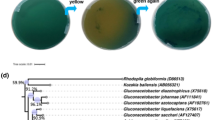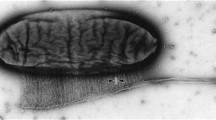Abstract
Bacterial cellulose (BC) is a biopolymer principally synthetized by strains of the genus Komagataeibacter. However, high costs and low production yield make large-scale application difficult. The aim of this work was to evaluate the effects of successive batch culture before fermentation on the ability to increase the capacity of bacterial cellulose biosynthesis by a low-producing strain. The Komagataeibacter hansenii strain ATCC 23,769 was initially cultivated in fermentation broth for two periods of 35 or 56 days under static conditions. At the end of each period of time, they were transferred to new broth to be cultivated again (new batch culture cycle) for 35 or 56 days and carried out in parallel with a 10-day fermentation to determine the quantity of BC produced. As a result, a greater increase was observed after the end of the second and third batch cultures of 56 days (increases of 137% and 187% in relation to the nonbatch cultured strain, respectively). The produced samples presented higher crystallinity and thermal properties but lower water holding capacity. Through this work, it was concluded that the longer the batch culture time was, the greater the increase in the capacity of cellulose biosynthesis, which also depended on the number of successive batch culture cycles carried out.






Similar content being viewed by others
Data availability
All data generated or analyzed during this study are included in this published article.
References
Gomes RJ, Borges MF, Rosa MF, Castro-Gómez RJH, Spinosa WA (2018) Acetic acid bacteria in the food industry: systematics, characteristics and applications. Food Technol Biotechnol 56:139–151. https://doi.org/10.17113/ftb.56.02.18.5593
Kadier A, Ilyas RA, Huzaifah MRM, Harihastuti N, Sapuan SM, Harussani MM, Azlin MNM, Yuliasni R, Ibrahim R, Atikah MSN, Wang J, Chandrasekhar K, Islam MA, Sharma S, Punia S, Rajasekar A, Asyraf MRM, Ishak MR (2021) Use of industrial wastes as sustainable nutrient sources for bacterial cellulose (BC) production: mechanism, advances, and future perspectives. Polymers 13:3365. https://doi.org/10.3390/polym13193365
Liu M, Liu L, Jia S, Li S, Zou Y, Zhong C (2018) Complete genome analysis of Gluconacetobacter xylinus CGMCC 2955 for elucidating bacterial cellulose biosynthesis and metabolic regulation. Sci Rep 8:1–10. https://doi.org/10.1038/s41598-018-24559-w
Wang J, Tavakoli J, Tang Y (2019) Bacterial cellulose production, properties and applications with different culture methods–a review. Carbohydr Polym 219:63–76. https://doi.org/10.1016/j.carbpol.2019.05.008
El-Gendi H, Taha TH, Ray JB, Saleh AK (2022) Recent advances in bacterial cellulose: a low-cost effective production media, optimization strategies and applications. Cellulose 29:7495–7533. https://doi.org/10.1007/s10570-022-04697-1
Choi SM, Rao KM, Zo SM, Shin EJ, Han SS (2022) Bacterial cellulose and its applications. Polymers 14:1080. https://doi.org/10.3390/polym14061080
Shigematsu T, Takamine K, Kitazato M, Morita T, Naritomi T, Morimura S, Kida K (2005) Cellulose production from glucose using a glucose dehydrogenase gene (gdh)-deficient mutant of Gluconacetobacter xylinus and its use for bioconversion of sweet potato pulp. J Biosci Bioeng 99:415–422. https://doi.org/10.1263/jbb.99.415
Ullah H, Wahid F, Santos HA, Khan T (2016) Advances in biomedical and pharmaceutical applications of functional bacterial cellulose-based nanocomposites. Carbohydr Polym 150:330–352. https://doi.org/10.1016/j.carbpol.2016.05.029
Hungund BS, Gupta SG (2010) Strain improvement of Gluconacetobacter xylinus NCIM 2526 for bacterial cellulose production. Afr J Biotechnol 9:5170–5172
Wu RQ, Li ZX, Yang JP, Xing XH, Shao DY, Xing KL (2010) Mutagenesis induced by high hydrostatic pressure treatment: a useful method to improve the bacterial cellulose yield of a Gluconoacetobacter xylinus strain. Cellulose 17:399–405. https://doi.org/10.1007/s10570-009-9388-8
Gomes RJ, Ida EI, Spinosa WA (2022) Nutritional supplementation with amino acids on bacterial cellulose production by Komagataeibacter intermedius: effect analysis and application of response surface methodology. Appl Biochem Biotechnol 194:5017–5036. https://doi.org/10.1007/s12010-022-04013-4
Costa AFS, Rocha MAV, Sarubbo LA (2017) Bacterial cellulose: an ecofriendly biotextile. Int J Fash Technol Text Eng 7:11–26
Núñez D, Cáceres R, Ide W, Varaprasad K, Oyarzún P (2020) An ecofriendly nanocomposite of bacterial cellulose and hydroxyapatite efficiently removes lead from water. Int J Biol Macromol 165:2711–2720. https://doi.org/10.1016/j.ijbiomac.2020.10.055
Segal LGJMA, Creely JJ, Martin AE Jr, Conrad CM (1959) An empirical method for estimating the degree of crystallinity of native cellulose using the X-ray diffractometer. Text Res J 29:786–794. https://doi.org/10.1177/004051755902901003
Feng X, Ullah N, Wang X, Sun X, Li C, Bai Y, Chen L, Li Z (2015) Characterization of bacterial cellulose by Gluconacetobacter hansenii CGMCC 3917. J Food Sci 80:E2217–E2227. https://doi.org/10.1111/1750-3841.13010
Teixeira SRZ, Reis EMD, Apati GP, Meier MM, Nogueira AL, Garcia MCF, Schneider ALS, Pezzin APT, Porto LM (2019) Biosynthesis and functionalization of bacterial cellulose membranes with cerium nitrate and silver nanoparticles. Mater Res 22:e20190054. https://doi.org/10.1590/1980-5373-MR-2019-0054
Chandrasekaran PT, Bari NK, Sinha S (2017) Enhanced bacterial cellulose production from Gluconobacter xylinus using super optimal broth. Cellulose 24:4367–4381. https://doi.org/10.1007/s10570-017-1419-2
Kačuráková M, Smith AC, Gidley MJ, Wilson RH (2002) Molecular interactions in bacterial cellulose composites studied by 1D FT-IR and dynamic 2D FT-IR spectroscopy. Carbohydr Res 337:1145–1153. https://doi.org/10.1016/S0008-6215(02)00102-7
Kondo T (1997) The assignment of IR absorption bands due to free hydroxyl groups in cellulose. Cellulose 4:281–292. https://doi.org/10.1023/A:1018448109214
Sugiyama J, Persson J, Chanzy H (1991) Combined infrared and electron diffraction study of the polymorphism of native celluloses. Macromolecules 24:2461–2466. https://doi.org/10.1021/ma00009a050
Wada M, Okano T (2001) Localization of Iα and Iβ phases in algal cellulose revealed by acid treatments. Cellulose 8:183–188. https://doi.org/10.1023/A:1013196220602
Pandit A, Kumar R (2021) A review on production, characterization and application of bacterial cellulose and its biocomposites. J Polym Environ 29:2738–2755. https://doi.org/10.1007/s10924-021-02079-5
Krystynowicz A, Czaja W, Wiktorowska-Jezierska A, Gonçalves-Miśkiewicz M, Turkiewicz M, Bielecki S (2002) Factors affecting the yield and properties of bacterial cellulose. J Ind Microbiol 29:189–195. https://doi.org/10.1038/sj.jim.7000303
Ahmed J, Gultekinoglu M, Edirisinghe M (2020) Bacterial cellulose micronano fibers for wound healing applications. Biotechnol Adv 41:107549. https://doi.org/10.1016/j.biotechadv.2020.107549
Campano C, Balea A, Blanco A, Negro C (2016) Enhancement of the fermentation process and properties of bacterial cellulose: a review. Cellulose 23:57–91. https://doi.org/10.1007/s10570-015-0802-0
Gomes RJ, Faria-Tischer PCS, Tischer CA, Constantino LV, Rosa MF, Chideroli RT, Pereira UP, Spinosa WA (2021) Komagataeibacter intermedius V-05: an acetic acid bacterium isolated from vinegar industry, with high capacity for bacterial cellulose production in soybean molasses medium. Food Technol Biotechnol 59:432–442. https://doi.org/10.17113/ftb.59.04.21.7148
Pogorelova N, Rogachev E, Digel I, Chernigova S, Nardin D (2020) Bacterial cellulose nanocomposites: morphology and mechanical properties. Materials 13:2849. https://doi.org/10.3390/ma13122849
Peng S, Zheng Y, Wu J, Wu Y, Ma Y, Song W, Xi T (2012) Preparation and characterization of degradable oxidized bacterial cellulose reacted with nitrogen dioxide. Polym Bull 68:415–423. https://doi.org/10.1007/s00289-011-0550-8
Mohite BV, Patil SV (2014) Physical, structural, mechanical and thermal characterization of bacterial cellulose by G. hansenii NCIM 2529. Carbohydr Polym 106:132–141. https://doi.org/10.1016/j.carbpol.2014.02.012
Sommer A, Staroszczyk H, Sinkiewicz I, Bruździak P (2021) Preparation and characterization of films based on disintegrated bacterial cellulose and montmorillonite. J Polym Environ 29:1526–1541. https://doi.org/10.1007/s10924-020-01968-5
Stanisławska A, Staroszczyk H, Szkodo M (2020) The effect of dehydration/rehydration of bacterial nanocellulose on its tensile strength and physicochemical properties. Carbohydr Polym 236:116023. https://doi.org/10.1016/j.carbpol.2020.116023
Vazquez A, Foresti ML, Cerrutti P, Galvagno M (2013) Bacterial cellulose from simple and low cost production media by Gluconacetobacter xylinus. J Polym Environ 21:545–554. https://doi.org/10.1007/s10924-012-0541-3
Li X, Li J, Gong J, Kuang Y, Mo L, Song T (2018) Cellulose nanocrystals (CNCs) with different crystalline allomorph for oil in water Pickering emulsions. Carbohydr Polym 183:303–310. https://doi.org/10.1016/j.carbpol.2017.12.085
Fan X, Gao Y, He W, Hu H, Tian M, Wang K, Pan S (2016) Production of nano bacterial cellulose from beverage industrial waste of citrus peel and pomace using Komagataeibacter xylinus. Carbohydr Polym 151:1068–1072. https://doi.org/10.1016/j.carbpol.2016.06.062
Chen G, Wu G, Chen L, Wang W, Hong FF, Jönsson LJ (2019) Comparison of productivity and quality of bacterial nanocellulose synthesized using culture media based on seven sugars from biomass. Microb Biotechnol 12:677–687. https://doi.org/10.1111/1751-7915.13401
Martínez-Sanz M, Olsson RT, Lopez-Rubio A, Lagaron JM (2011) Development of electrospun EVOH fibers reinforced with bacterial cellulose nanowhiskers. Part I: characterization and method optimization. Cellulose 18:335–347. https://doi.org/10.1007/s10570-010-9471-1
Barud H, Ribeiro C, Crespi M, Martines M, Dexpert-Ghys J, Marques R, Messaddeq Y, Ribeiro S (2007) Thermal characterization of bacterial cellulose–phosphate composite membranes. J Therm Anal Calorim 87:815–818. https://doi.org/10.1007/s10973-006-8170-5
Barud HS, Araújo Júnior AM, Santos DB, Assunção RM, Meireles CS, Cerqueira DA, Rodrigues Filho G, Ribeiro CA, Messaddeq Y, Ribeiro SJ (2008) Thermal behavior of cellulose acetate produced from homogeneous acetylation of bacterial cellulose. Thermochim Acta 471:61–69. https://doi.org/10.1016/j.tca.2008.02.009
Vasconcelos NF, Feitosa JPA, Gama FMP, Morais JPS, Andrade FK, Souza MDSM, Rosa MF (2017) Bacterial cellulose nanocrystals produced under different hydrolysis conditions: properties and morphological features. Carbohydr Polym 155:425–431. https://doi.org/10.1016/j.carbpol.2016.08.090
Souza EF, Furtado MR, Carvalho CW, Freitas-Silva O, Gottschalk LM (2020) Production and characterization of Gluconacetobacter xylinus bacterial cellulose using cashew apple juice and soybean molasses. Int J Biol Macromol 146:285–289. https://doi.org/10.1016/j.ijbiomac.2019.12.180
Ozen E, Yildirim N, Dalkilic B, Ergun ME (2021) Effects of microcrystalline cellulose on some performance properties of chitosan aerogels. Maderas Cienc Tecnol 23:1–10. https://doi.org/10.4067/s0718-221x2021000100426
Lin SP, Liu CT, Hsu KD, Hung YT, Shih TY, Cheng KC (2016) Production of bacterial cellulose with various additives in a PCS rotating disk bioreactor and its material property analysis. Cellulose 23:367–377. https://doi.org/10.1007/s10570-015-0855-0
Molina-Ramírez C, Cañas-Gutiérrez A, Castro C, Zuluaga R, Gañán P (2020) Effect of production process scale-up on the characteristics and properties of bacterial nanocellulose obtained from overripe Banana culture medium. Carbohydr Polym 240:116341. https://doi.org/10.1016/j.carbpol.2020.116341
Huang HC, Chen LC, Lin SB, Hsu CP, Chen HH (2010) In situ modification of bacterial cellulose network structure by adding interfering substances during fermentation. Bioresour Technol 101:6084–6091. https://doi.org/10.1016/j.biortech.2010.03.031
Lin SB, Hsu CP, Chen LC, Chen HH (2009) Adding enzymatically modified gelatin to enhance the rehydration abilities and mechanical properties of bacterial cellulose. Food Hydrocoll 23:2195–2203. https://doi.org/10.1016/j.foodhyd.2009.05.011
Ul-Islam M, Khan T, Park JK (2012) Water holding and release properties of bacterial cellulose obtained by in situ and ex situ modification. Carbohydr Polym 88:596–603. https://doi.org/10.1016/j.carbpol.2012.01.006
Wu JM, Liu RH (2013) Cost-effective production of bacterial cellulose in static cultures using distillery wastewater. J Biosci Bioeng 115:284–290. https://doi.org/10.1016/j.jbiosc.2012.09.014
Bandyopadhyay S, Saha N, Sáha P (2018) Characterization of bacterial cellulose produced using media containing waste apple juice. Appl Biochem Microbiol 54:649–657. https://doi.org/10.1134/S0003683818060042
Acknowledgements
We would like to thank “Laboratório de Espectroscopia (ESPEC)” and “Laboratório de Difração de Raios X (LabDRX)” of the State University of Londrina for providing equipment and assistance in the chemical characterization analyses.
Funding
We thank “Conselho Nacional de Desenvolvimento Científico e Tecnológico (CNPq)” for providing scholarship to Rodrigo J. Gomes (Grant number: 142380/2017–2) and research fellowship to Wilma A. Spinosa (Grant number: 307846/2020–2).
Author information
Authors and Affiliations
Contributions
R.J. Gomes contributed to the conception and design of the studies, performed the experiments, analyzed the experimental data, and wrote the manuscript; E.I. Ida contributed to the critical revision of the manuscript. W.A. Spinosa contributed to the supervision, provided lab space, and acquired funding for this work. All authors read and approved the final manuscript.
Corresponding author
Ethics declarations
Ethics approval
This article does not contain any studies with human participants or animals performed by any of the authors.
Consent to participate
Not applicable.
Consent for publication
Not applicable.
Conflict of interest
The authors declare no competing interests.
Additional information
Publisher's Note
Springer Nature remains neutral with regard to jurisdictional claims in published maps and institutional affiliations.
Rights and permissions
Springer Nature or its licensor (e.g. a society or other partner) holds exclusive rights to this article under a publishing agreement with the author(s) or other rightsholder(s); author self-archiving of the accepted manuscript version of this article is solely governed by the terms of such publishing agreement and applicable law.
About this article
Cite this article
Gomes, R.J., Ida, E.I. & Spinosa, W.A. Bacterial cellulose production by Komagataeibacter hansenii can be improved by successive batch culture. Braz J Microbiol 54, 703–713 (2023). https://doi.org/10.1007/s42770-023-00910-w
Received:
Accepted:
Published:
Issue Date:
DOI: https://doi.org/10.1007/s42770-023-00910-w




